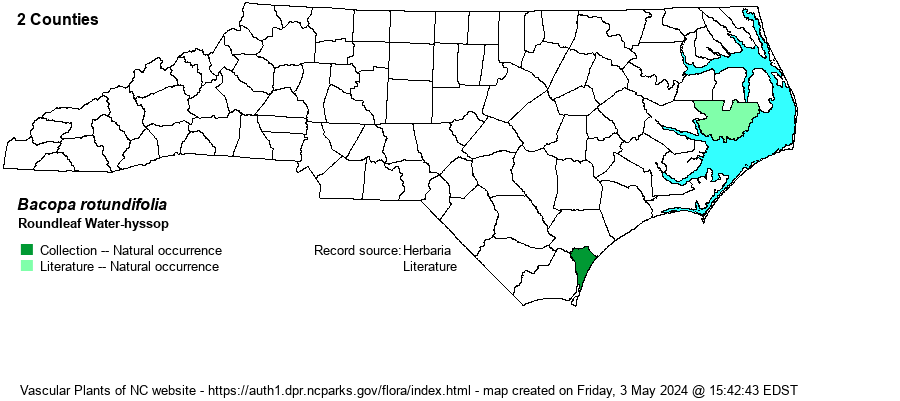| Author | (Michaux) Wettstein | |
| Distribution | There is a report (but no specimens?) from Lake Mattamuskeet (Hyde County) in 1929, according to Weakley (2018) and the NCNHP database. Two vegetation plot records for Pender County, in 2004 along the lower Black River at Roan Island, were searched in 2022 and plants were not present; instead, only Micranthemum umbrosum was found and abundant. The SERNEC database has a specimen from Harnett County, but the specimen is misidentified (fide Sorrie 2022). A "Research Grade" photo from Wake County on iNaturalist appears instead to be a non-native species of Ludwigia! Finally, 2 specimens from Wilmington, New Hanover County, one in 1900 and one undated, are both annotated to B. rotundifolia by F.W. Pennell, an expert in the genus. We accept these last 2 records as proof of occurrence in NC.
This is essentially a Midwestern species of Bacopa, and any record for an Atlantic Coast state is open to question regarding provenance. It ranges east mostly to IN, central KY, and AL; records area available for a few counties in MD, VA, NC, SC, GA, and FL, generally near the coast. | |
| Abundance | It is considered as state Significantly Rare by the NCNHP, and both this agency and Weakley (2022) consider it as of historical (SH) occurrence. | |
| Habitat | As with others in the genus, this species grows in very shallow water or on mud, around lake margins, pools, and marsh edges. | |
| Phenology | Blooms from May to September, and fruits shortly after flowering. | |
| Identification | This is a species with opposite, entire, and rounded leaves, with some of the stems growing under the water surface. Each leaf is much larger than on other Bacopa species, these being about 1.5 inches long and nearly as wide, often floating on the water, and rather thin in texture. Thus, it is less mat-forming than the other species. It can have 2-4 flowers from the leaf axils, rather than just solitary, and these flowers are fairly large and white with a yellow center; the spread flower is about 3/4-inch across. B. caroliniana has ovate leaves, is strongly mat-forming, and has blue flowers, plus is fragrant when bruised. B. monnieri has obovate to spatulate leaves, widest near the tip. There are a few other species with roundish, opposite leaves that grow in mud or shallow water, especially the exotic Creeping Jenny (Lysimachia nummularia); if flowers are not visible, one can always wonder it this very rare Bacopa was correctly identified on the vegetation plot surveys. | |
| Taxonomic Comments | A former named species -- B. simulans -- also considered endemic to coastal marshes and wetlands in VA and MD, as with B. stragula -- is also considered by experts to be another "intertidal form", this one of B. rotundifolia. See Weakley (2018) for more information.
| |
| Other Common Name(s) | Disk Water-hyssop, Midwestern Water-hyssop | |
| State Rank | SH | |
| Global Rank | G5 | |
| State Status | SR-D | |
| US Status | | |
| USACE-agcp | OBL link |
| USACE-emp | OBL link |

